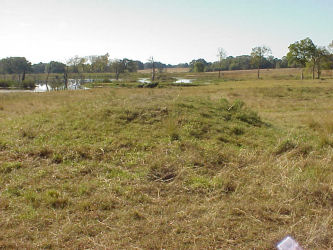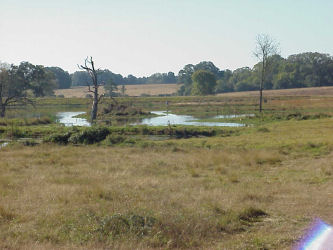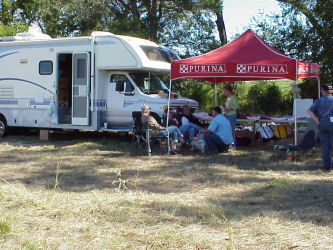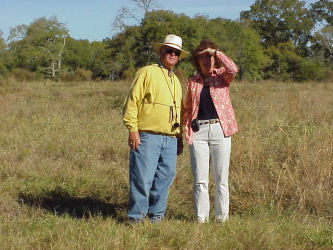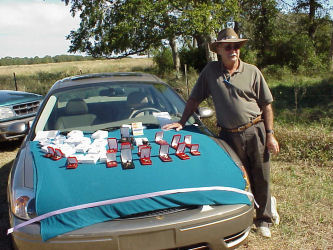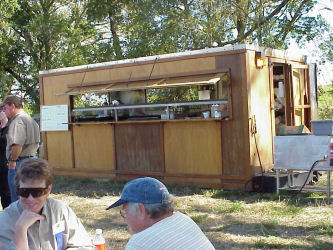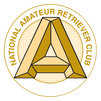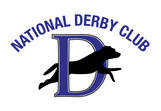Monday, November 8, 2004 |
It was cloudy and cool, with temperatures around 50
and little breeze as dawn arrived. Weather forecast a high in the
seventies later.
Once on site, everything was ready to finish the previous tests. At 7:15, the only test team of Jon and Hunter did well. Visibility was good and the starting dog, 20, initiated the remaining series shortly after. Work was quite similar to the previous day but a switching wind appeared to make the left mark more difficult than before. It concluded at 9:05 when dog 37 returned with the blind.
As a water blind was being organized in the same area, callbacks were announced. Five had been lost. They were:12, 26, 31, 35, and 47. Seventy-four would try the third.
The mat was moved to a few yards behind the same mound the previous series had been run from. It became a "no-see-um"
start to the blind. To recover the dead rooster, dogs had to go over the mound and angle down the field a good distance to the water. The line continued through a small bay of water, over a strip of land and back into the water. It was lunging water that passed a green, submerged point on the left. Once past it, the line passed an island on the left (also with a tempting point)
to a thick, raised point on the right. To stay on line, dogs had to take a piece of that point , get back into the water and swim past a receding shoreline to the nest point. The bird lay about 275 yards from line
The mound prevented a clear view of what line the handler wanted and many went over it , then paralleled the shore. Others went to the left, trying to go "fat" into the pond. It was difficult to keep dogs on line with the numerous changes and reentry's. A switching wind could deflect dogs from a good line and a "coon devil" tempted them to land between the last point and the water between it and the next one where the bird was. The test took 7-8 minutes per dog
Shortly afternoon, the wind again switched and blew across the test from left to right. Then a cast away from the right shore was also a cast into the wind. The shore, already tempting, became even more so. Deep into the test, dogs that refused casts into wind and water, and could disappear behind the farthest point. They often reappeared on the far right, hunting around the planters' blind, well out of the area and out of control. A number picked up while others handled many times to keep their dogs in sight and on line. This pattern occurred for several hours although there were a number of good jobs, also. Later, the wind abated and work became better.
By 4:30 p.m., lengthening shadows began to obscure the last third of the site. At 5. p.m., judges suspended the test after dog 32 because of deteriorating lighting conditions. It will resume at Tues. at 7 a.m. with dog 33. There are 23 dogs left to run.
The next test will be water marks a short distance from the current site. Starting dog will be 78 or the next closest one.
Once on site, everything was ready to finish the previous tests. At 7:15, the only test team of Jon and Hunter did well. Visibility was good and the starting dog, 20, initiated the remaining series shortly after. Work was quite similar to the previous day but a switching wind appeared to make the left mark more difficult than before. It concluded at 9:05 when dog 37 returned with the blind.
As a water blind was being organized in the same area, callbacks were announced. Five had been lost. They were:12, 26, 31, 35, and 47. Seventy-four would try the third.
The mat was moved to a few yards behind the same mound the previous series had been run from. It became a "no-see-um"
start to the blind. To recover the dead rooster, dogs had to go over the mound and angle down the field a good distance to the water. The line continued through a small bay of water, over a strip of land and back into the water. It was lunging water that passed a green, submerged point on the left. Once past it, the line passed an island on the left (also with a tempting point)
to a thick, raised point on the right. To stay on line, dogs had to take a piece of that point , get back into the water and swim past a receding shoreline to the nest point. The bird lay about 275 yards from line
The mound prevented a clear view of what line the handler wanted and many went over it , then paralleled the shore. Others went to the left, trying to go "fat" into the pond. It was difficult to keep dogs on line with the numerous changes and reentry's. A switching wind could deflect dogs from a good line and a "coon devil" tempted them to land between the last point and the water between it and the next one where the bird was. The test took 7-8 minutes per dog
Shortly afternoon, the wind again switched and blew across the test from left to right. Then a cast away from the right shore was also a cast into the wind. The shore, already tempting, became even more so. Deep into the test, dogs that refused casts into wind and water, and could disappear behind the farthest point. They often reappeared on the far right, hunting around the planters' blind, well out of the area and out of control. A number picked up while others handled many times to keep their dogs in sight and on line. This pattern occurred for several hours although there were a number of good jobs, also. Later, the wind abated and work became better.
By 4:30 p.m., lengthening shadows began to obscure the last third of the site. At 5. p.m., judges suspended the test after dog 32 because of deteriorating lighting conditions. It will resume at Tues. at 7 a.m. with dog 33. There are 23 dogs left to run.
The next test will be water marks a short distance from the current site. Starting dog will be 78 or the next closest one.

